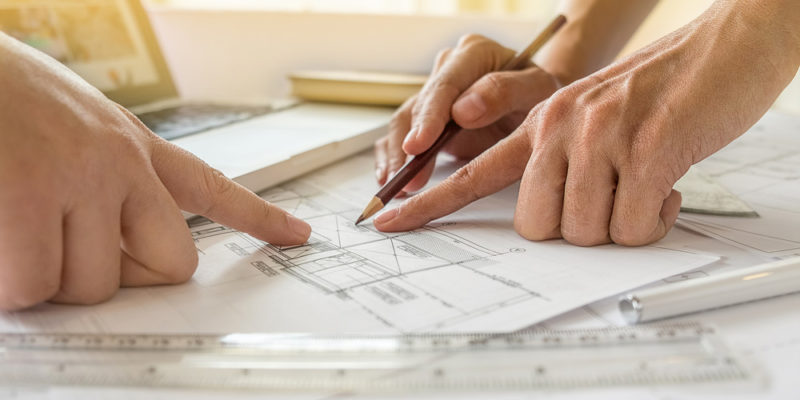6 Steps To Planning A Successful Building Project
There’s a strong temptation to dive straight into home remodeling projects. The sooner you start, the sooner you’ll be done, right? Unfortunately, it doesn’t work that way if you haven’t done some essential planning up front. Each design professional and contractor runs his or her business in a different way, but homeowners usually need to follow the same steps to get to the construction phase.
人们有一种强烈的冲动,想要直接投入到家庭装修项目中去。你出发得越早,完成得就越快,对吗?不幸的是,如果你没有提前做一些必要的计划,这就行不通了。每个设计专业人员和承包商以不同的方式经营他或她的业务,但业主通常需要遵循相同的步骤,以达到施工阶段。
Here are six crucial steps to help you plan for a successful home renovation, and the reasons they’re so important for any building project.
这里有六个关键的步骤来帮助你计划一个成功的家庭装修,以及他们对任何项目如此重要的原因。
1. Choose a design professional. To create a plan and detailed scope of work, most homeowners hire either an architect or interior designer, and sometimes both. Every company does things a little differently. Many designers work on projects that don’t involve major structural work or additions, and also offer assistance with material and color selections. Architects may take on a wide range of work, or work only on floor plans and permits, and leave the details of the electrical plan, baths and kitchen to another designer.
Selecting a design professional usually starts with an in-person meeting, which can take a few weeks depending on how many companies you are interviewing. This is your opportunity to understand the services that each firm offers and make sure they match up with what you are expecting. It’s also critical that you have a budget for your project in mind that you communicate clearly to the firm you hire, so the design can align with what you are planning to invest.
1. 选择一个专业的设计师。为了制定计划和详细的工作范围,大多数房主要么聘请建筑师,要么聘请室内设计师,有时两者兼而有之。每个公司的做法都略有不同。许多设计师从事的项目不涉及主要的结构工作或添加,也提供材料和颜色选择的帮助。建筑师可以承担广泛的工作,或者只在平面图和许可的范围内工作,而把电气平面图、浴室和厨房的细节留给另一个设计师。选择一个设计专业人士通常从一个面对面的会议开始,这可能需要几个星期,取决于你面试的公司的数量。这是你了解每家公司提供的服务的机会,并确保他们符合你的期望。同样重要的是,你心中要有一个项目预算,你要与你雇佣的公司清楚地沟通,这样设计才能与你的投资计划相一致。
2. Create a plan. After choosing a design firm, it’s time to start making a plan. There are usually at least two and sometimes three good ways to reach your design goals.
The plans are called schematic designs; they usually involve a rough layout of the floor plan and some simple views of the exterior of the home if there is an addition. It takes time for the design professional to work these out, and then usually another week or two for the homeowners to consider them and make decisions. If the project is larger or the homeowners want additional changes made to the schematics, this initial design phase can take several months.
2. 创建一个计划。在选择了一家设计公司之后,是时候开始制定计划了。通常至少有两到三种方法可以达到你的设计目标。这些计划被称为方案设计;他们通常包括一个粗略的平面布局和一些简单的外观,如果有一个额外的家。设计专业人员需要时间来解决这些问题,然后房主通常需要一两个星期来考虑并做出决定。如果项目规模较大,或者业主希望对示意图进行额外的更改,则初始设计阶段可能需要几个月的时间。
3. Interview contractors. Contractors are frequently brought into the process once a final schematic design has been selected. Usually there is at least a general idea of how the home will look from the outside, a dimensioned floor plan and some preliminary material selections. With this much information, it’s possible to provide preliminary estimates of cost.
Contractors are often asked to estimate the schematic design as part of the interview process. It may take a couple of weeks to set up the interviews and generally at least two to three weeks after interviews to receive the estimates. Altogether it could take four to six weeks to interview candidates and receive estimates. After that you may want to call references, visit jobsites or do additional research before making a decision about the contractor you will hire.
3.采访承包商。一旦选定了最终的方案设计方案,承包商就会经常参与这个过程。通常情况下,至少有一个大体的想法,从外观来看,一个尺寸的平面图和一些初步的材料选择。有了这么多的信息,就有可能提供成本的初步估计。作为面试过程的一部分,承包商经常被要求评估方案设计。可能需要几周的时间来安排面试,通常在面试后至少两到三周才能收到评估。总的来说,可能需要4到6周的时间来面试候选人,并接受评估。在那之后,你可能想要打电话给介绍人,参观工作场所或做额外的研究,然后再决定你将雇用的承包商。
4. Go shopping while others are engineering. Love to shop or hate to shop? This may determine whether you enlist a designer to help with your material selections. Even those who like to shop may be overwhelmed by all the options and want professional input. Do not underestimate the number of things that need to be selected, from doorknobs and windows to countertops and light fixtures. To really keep a handle on your project cost, it’s best to select every last thing ahead of construction. This will allow your contractor to tell you the prices for what you’d like and properly schedule material purchases based on lead times.
Allow yourself one to two months to choose everything. While you are shopping for tile and hardwood floors, your architect or designer will finalize construction drawings, work with a structural engineer on how the project will be built and put in the details required for permitting. If it all goes well, you will work on this step and the previous one concurrently and finish at the same time.
4. 当别人在搞工程的时候去购物。喜欢购物还是讨厌购物?这可能会决定你是否聘请设计师来帮助你选择材料。即使是那些喜欢购物的人,也可能会被各种各样的选择淹没,需要专业的意见。不要低估需要选择的东西的数量,从门把手和窗户到台面和灯具。为了真正控制项目成本,最好在施工前选择好每一件事。这将允许你的承包商告诉你你想要的价格,并根据交货时间合理安排材料采购。给自己一到两个月的时间来选择一切。当您购买瓷砖和硬木地板时,您的建筑师或设计师将完成施工图,与结构工程师一起工作,了解项目将如何建造,并提供所需的细节。如果一切顺利,您将同时处理这一步和前一步,并同时完成。
5. Get your permits. Depending on the scope of your project and where it’s located, permitting can take few days, few weeks or even few monthes . You should have some idea ahead of filing for permits about the length of the process, which will allow you to identify a likely start date for your project. Permit fees can range from a few hundred nz dollars to thousands of nz dollars, depending on where you live and how big your project is.
5. 得到你的许可。根据项目的范围和位置,许可可能需要几天、几周 甚至几个月的等待。在申请许可之前,你应该对这个过程的长度有所了解,这样你就可以确定你的项目可能的开始日期。许可费用从几百纽币到几千纽币不等,这取决于你住在哪里以及你的项目有多大。
6. Ready, set … With the plan submitted for permits and material selections made, your contractor will be able to finish up pricing and write up a contract for construction. If the selected materials cost more than the budget allows, there may be a round of “value engineering,” which means changing scope of work or materials to reduce cost. By the time the contract is signed, your contractor will have identified the longer-lead items (like cabinets, windows, doors, tile and sometimes plumbing or electrical fixtures) and may even have them on order ahead of the start of construction, depending on the timing of your project.
6. 准备好了,…有了提交的许可计划和材料选择,你的承包商将能够完成定价和写一份建设合同。如果所选材料的成本超过预算,可能会有一轮的价值工程,这意味着改变工作范围或材料,以降低成本。在合同签署的时候,你的承包商已经确定了较长时间的项目(比如橱柜、窗户、门、瓷砖,有时还有管道或电气装置),甚至可能在施工开始之前就已经订购了,这取决于你项目的时间安排。
By the time all of these steps are complete, it may be four to six months or even more since you started talking with design professionals.
The planning process can be lengthy, but each step you take will put you closer to starting your project with a clear vision of what’s to come. That investment of time on the front end means your entire construction team — design professional, contractor and you — can start the project on the same page with a clearly articulated plan. That makes it much easier say, “Go!” without any hesitation.
当所有这些步骤都完成时,可能需要4到6个月甚至更长时间才能开始与设计专家交谈。计划的过程可能是漫长的,但是你所采取的每一个步骤都会让你更接近开始你的项目时对未来有一个清晰的愿景。在前端的时间投资意味着你的整个施工团队的设计专业人员,承包商和你可以在同一页上开始项目与一个明确的计划。这样说来,说“走”就容易多了!没有任何犹豫。
